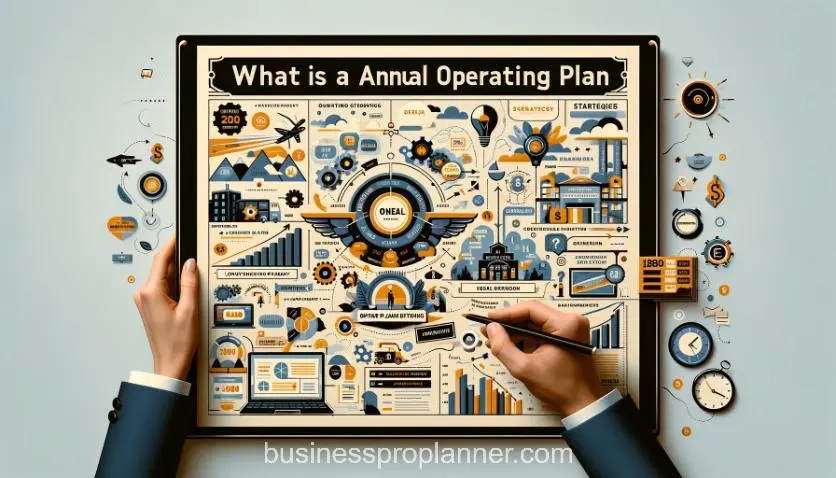An Annual Operating Plan (AOP) is a pivotal strategic planning document, that outlines a company’s objectives, plans, budget strategies, and actions for the next fiscal year. Developing a clear, thoughtful annual operating plan is crucial for aligning teams, allocating resources effectively, and guiding data-driven business growth.
Our detailed guide will cover what an AOP entails, its crucial role, and steps to craft a successful AOP for your organization’s planning process.
Key Takeaways
- An AOP outlines goals, budgets, and tactics for the fiscal year ahead.
- It aligns teams and guides data-driven decision-making.
- Its process involves forecasting, resource planning, and finalizing budgets.
- It differs from a long-term strategic plan.
- Effective AOPs require collaboration, leadership buy-in, and communication.
- An effective AOP requires collaboration, leadership approval, and clear communication.
What is an Annual Operating Plan?
An annual operating plan is a document that comprehensively outlines a business’s objectives, budgets, strategies, and tactical plans for the upcoming fiscal year, usually the next 12 months.
It provides a detailed roadmap for how a company will operate over the year ahead to achieve its goals and strategic priorities. The annual operating plan expands on the broader 3-5 years strategic plan, translating high-level strategy into specific operating plans.

For numerous companies, the yearly planning cycle typically produces two essential documents.
- Annual Operating Plan (AOP): Includes business objectives, initiatives, budgets, and tactics.
- Annual Budget: Detailed financial projections – P&L, cash flow, balance sheet.
The AOP and financial plan are closely intertwined, with the actions specified in the annual operating plan guiding the necessary budgeting. While “AOP,” “operations plan,” “operating budget,” and “annual business plan” are terms often used synonymously.
An annual operating plan is a comprehensive framework that integrates both organizational goals and financial strategies, essential for stakeholder engagement.
AOP vs. Annual Budget
The annual operating plan and annual budget are interconnected:

| AOP | Annual Budget |
|---|---|
| Defines objectives, initiatives, tactics | Provides detailed financial projections |
| Covers 12-month period | 12-month fiscal year |
| Sets KPIs to track | Contains P&L, cash flow, balance sheet |
| Guides activities and resources | Used for cost control and monitoring |
| Created first to inform budget | Created based on AOP resource needs |
The annual operating plan outlines operating plans while the budget quantifies the revenues, costs, and resources needed to execute those plans. The two core documents develop iteratively during the annual planning process.
Why Is an AOP Important for Business?
An effective annual operating plan provides tremendous value:
Alignment:
- Gets all teams working towards shared goals.
- Ensures alignment with corporate strategy.
Decision-Making:
- Drives data-driven resource allocation.
- Provides rationale for initiatives.
Accountability:
- Sets KPIs and metrics for tracking.
- Improves organization-wide accountability.
Growth:
- Focuses teams on driving revenue growth.
- Reveals market opportunities to pursue.
Without a well-defined AOP, departments can lose alignment and cohesion. An AOP brings everything together into an integrated plan.
Implementing an AOP helps businesses scale operations and accelerate growth in a strategic, coordinated way. An AOP is vital for any organization that wants to achieve its full potential.
AOP vs. Strategic Plan
The AOP differs from a strategic plan:

| AOP | Strategic Plan |
|---|---|
| 12-month timeframe | 3-5 year timeframe |
| Tactical execution plan | High-level vision and direction |
| Details – budgets, initiatives, KPIs | Broad objectives and priorities |
| Concrete and quantitative | Conceptual and directional |
| Fiscal year focus | Ongoing strategic framework |
| Requires yearly updates | Reviewed less frequently |
| Operational activities | Overarching mission and vision |
The AOP executes on the current fiscal year portion of the long-term corporate strategy. The two plans align and complement each other.
Creating an Effective AOP: The Process
Here is an overview of the key steps in the AOP process:
- Gather Inputs from All Departments: Finance leads the annual operating plan process but all business units provide critical inputs on goals, initiatives, and resource needs.
- Analyze Business Environment: Review growth objectives, market trends, competitive landscape, risks, and opportunities.
- Define Corporate Objectives and KPIs: Set company-wide objectives and KPIs aligned with strategic goals.
- Make Data-Driven Forecasts: Develop projections for sales, revenue, and customers based on historical data and market analysis.
- Determine Tactical Initiatives: Define specific initiatives across all departments required to hit targets.
- Create Budgets: Build operating expense, capital expenditure, and headcount budgets factoring in initiative costs.
- Consolidate into AOP Document: Bring together objectives, plans, budgets, and KPIs into an integrated annual operating plan.
- Gain Leadership Approval: Review the annual operating plan with executives and the board to get sign-off. Adjust as needed.
- Communicate for Alignment: Share AOP across the organization for transparency and alignment.
This stage-gate process enables thoughtful, collaborative annual operating plan creation aligned with the company’s strategy and market realities.
Elements of an Effective AOP
While AOP formats vary across organizations, some typical sections include:
- Executive Summary: Highlights key goals, initiatives, budgets, and metrics.
- Company Objectives: Quantified targets – revenue, profitability, customer metrics.
- Department Plans: Tactical plans and budgets for Sales, Marketing, Technology, etc.
- Financial Projections: P&L forecast, balance sheet, cash flow forecasts.
- KPIs: Key performance indicators include key metrics across Sales, Marketing, Operations, HR and other departments.
- Initiatives: Major projects and programs needed to hit objectives.
- Risks and Mitigation Plans: Assessment of potential risks and mitigation strategies.
- Operating Expenses: Planned spending by department.
- Headcount Plan: Number of planned new hires aligned with growth.
- Capital Expenditures: Investments in property, equipment, and technology.
Tips for Developing an Effective AOP
Here are some best practices to create a high-quality, actionable annual operating plan:
- Collaborate extensively – involve all departments in the process.
- Ensure alignment with strategic priorities.
- Make data-driven forecasts and budgets.
- Assign owners to initiatives to ensure accountability.
- Build flexibility to adapt to changing conditions.
- Communicate the plan widely across the organization.
- Define success metrics for key goals and initiatives.
- Review quarterly to track progress and adjust as needed.
Significance of the AOP for Business Success
A well-constructed annual operating plan is invaluable for executing strategy and driving business growth, such as:
- Gives a detailed roadmap for the year ahead.
- Enables teams to develop tactics to achieve strategic objectives.
- Drives data-based decision-making on investments.
- Promotes transparency around resource allocation.
- Creates focus and urgency to drive revenue growth.
- Allows performance tracking versus plan.
For companies that create and execute a thoughtful annual operating plan, it can propel growth and success.

Conclusion
An annual operating plan is a critically important document that guides a company’s priorities and actions. Developing an effective AOP through collaborative planning, number-crunching, and clear communication sets up the organization for success.
With a well-constructed annual operating plan, companies can align cross-functional teams, optimize decision-making on investments and initiatives, and ultimately drive growth and performance.
Taking the time to create a thoughtful, comprehensive provides the blueprint for executing business strategy and accelerating progress in the dynamic marketplace.
